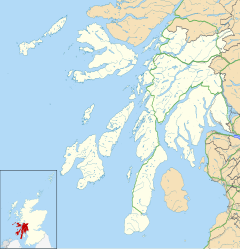Human settlement in Scotland
| Shandon | |
|---|---|
 The former St Andrew's School, Shandon House The former St Andrew's School, Shandon House | |
 | |
| OS grid reference | NS267840 |
| Council area | |
| Lieutenancy area | |
| Country | Scotland |
| Sovereign state | United Kingdom |
| Post town | HELENSBURGH |
| Postcode district | G84 |
| Police | Scotland |
| Fire | Scottish |
| Ambulance | Scottish |
| UK Parliament | |
| Scottish Parliament | |
| 56°02′35″N 4°48′20″W / 56.04306°N 4.80556°W / 56.04306; -4.80556 | |
Shandon is an affluent settlement of houses forming a village on the open sea loch of the Gare Loch in Argyll and Bute, Scotland. Shandon overlooks the Rosneath Peninsula to the west and is bordered by Glen Fruin (Scottish Gaelic: Gleann Freòin) to the east, which is the site of the Battle of Glen Fruin, one of the last clan battles in Scotland, fought on 7 February 1603, in which an estimated 300 warriors on foot from the MacGregor Clan claimed victory over an estimated 600–800 men from the Colquhoun Clan on horse-back.
Shandon is 4 miles (6 kilometres) northwest of Helensburgh, 9 miles (14 kilometres) west of Loch Lomond and 33 miles (53 kilometres) northwest of Glasgow city centre. Formerly in the county of Dunbartonshire, it developed alongside other similar settlements in the area, in the 19th century, from a hamlet to a fashionable residential area for wealthy Glasgow merchants and several mansion houses still remain. Shandon Castle and Faslane Castle, dating from the Medieval age once occupied prominent positions in the area.
West Shandon House, built in the 1840s by John Thomas Rochead for Robert Napier, often described as 'the father of Clyde shipbuilding' was a prominent landmark and was renowned for housing Napier's extensive art collection. It later became a hydropathic institution,
Since the 1960s, His Majesty's Naval Base Clyde has been based between the outskirts of Shandon and the village of Garelochhead at Faslane, and it occupies the whole of the former grounds of West Shandon House.
Shandon House, designed by Charles Wilson for William Jamieson, became a reform school named St Andrew's, from 1965 until 1986. It is currently owned by the Ministry of Defence who had plans to make it into accommodation for Royal Marines serving at the Naval Base nearby. It lies behind Faslane Peace Camp, derelict and boarded up.
External links
- West Shandon House
- TURKISH baths at Shandon House in the Helensburgh Heritage
 Media related to Shandon, Argyll at Wikimedia Commons
Media related to Shandon, Argyll at Wikimedia Commons
References
- Howard, Fiona (26 January 2010). "Turkish Baths at Shandon". Helensburgh Heritage.
- Osborne, Brian D (1991), Robert Napier: The Father of Clyde Shipbuilding, Dumbarton, Scotland: Dumbarton District Libraries, archived from the original on 31 January 2002, retrieved 21 April 2010
- Bradley, James; Dupree, Mageurite; Durie, Alastair (1997). "Taking the Water Cure: The Hydropathic Movement in Scotland, 1840-1940" (PDF). Business and Economic History. 26 (2): 429. Retrieved 17 November 2009.
- Shifrin, Malcolm (3 October 2008). "Shandon Hydropathic Establishment: Dunbartonshire, Scotland". Victorian Turkish Baths: Their origin, development, and gradual decline. Retrieved 12 December 2009.
- "Shandon House, Shore Road, Shandon". Buildings at Risk Register for Scotland. February 1990.
- Higginbotham, Peter (2022). "St Andrew's School, Shandon, Helensburgh, Dunbartonshire, Scotland". Children's Homes.